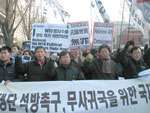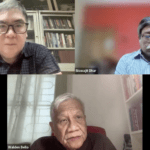Thus began the march of good governance as the most important new pillar in international development discourse, second only to poverty reduction. Governance-related reforms (civil service and judicial reform, regulatory and market governance), in some cases compiled in a comprehensive governance masterplan or action plan, became one of the hottest initiatives coming from the IFIs/MDBs.
One would not have begrudged the IFIs/MDBs their claim of the moral high ground had institutional memory been short. Fortunately such was not the case. Most everybody remembers that the IFIs/MDBs definitely hugged the policy limelight during the darkest and most repressive era of East Asia. They have, for instance, stayed on and shored up the Suharto regime in Indonesia, even at a time when civil society was already appealing for their withdrawal of support. The World Bank and the International Monetary Fund had been known to manipulate certain country data to justify their loan programs in the past. And the U.S. Congress appointed International Financial Advisory Commission (also known as the Meltzer Commission) reported in early 2000 that more than half of World Bank projects were failures.
The most damning revelation came with the collapse of American electricity equipment and supply giant, Enron Corporation. Enron registered the biggest bankruptcy in U.S. history to date, leaving on its trail more than US$140 billion in debts. Not only did the most powerful country in the world fail to arrest the situation before it exploded, it was also revealed that Enron thrived with its financial support. According to the Institute for Policy Studies (IPS), a U.S.-based progressive policy think tank, "since 1992, at least 21 agencies, representing the U.S. government, multilateral development banks, and other national governments, helped leverage Enron's global reach by approving $7.219 billion in public financing toward 38 projects in 29 countries" .2
Closer to home, the governance discourse has also been actively promoted by the Asian Development Bank. The ADB has been cited by the same IPS report as having "supported (Enron's) Batangas Power Plant with a $26.4 million loan"3 . Official ADB documents show that the loan was approved in 1993 from the Bank's Ordinary Capital Resources, and that the Bank also made an equity investment to the plant in the amount of US$3 million 4.
The irony of Enron is not so much that it went bankrupt. But that, being a private corporation, it was subject to less nagging over governance issues than governments were. The irony is that the private sector has long been pitted against the public sector, hailed as the better of the two, and in the 1990s been the recipient of much direct support from the MDBs.
As the ADB Says, Not as it Does
The ADB prides itself for being the first to have a Board-approved governance policy. This policy has four core elements – accountability, participation, predictability and transparency. The governance activities the Bank supports in developing members countries (DMCs) revolve around the following objectives: to (1) strengthen governance in public sector management; (2) improve public enterprise management and public-private interface; (3) improve public expenditure management; (4) support public administration reform; (5) enhance participation; (6) decentralise government services; and (7) reform the legal system.5
However, the ADB does not always practice what it preaches.
Internally, the ADB is very centralised and hires personnel based on criteria other than merit. A Department for International Development (DFID, UK) study pushed for institutional and management reform within the ADB. DFID claims that "the Bank remains a higly centralised organisation with most decisions taken at its headquarters in Manila", that "in-country offices are…restricted to project implementation, logistical support and liaison with the host government" and lack "policy responsibility", a situation that challenges the "traditional merit of a Regional Development Bank being closer to its borrowing member countries"6. DFID further sees the operation of "a quota system for professional staff (i.e., the number of staff of a particular nationality depends on the size of that country's shareholdings)" and the reservation of certain posts for particular countries, an anomaly 7. This quota system is responsible for having the most senior management posts occupied by Japanese and American nationals. The Presidency, the Treasury and Budget portfolios are reserved for the Japanese, while the Americans take charge of the General Counsel's Office.
How the ADB handles projects and programs in DMCs is itself not a source of good examples. Projects with implications on resettlement almost always fail to incorporate meaningful participation (versus mere consultation) with affected communities. Relevant information are not made available on time, if at all. Although one wonders whether the production and/or possession of conclusive pieces of evidence (whether positive or negative) is really more important to the Bank than actually having a project or program implemented come what may.
The latest scandal to prick the ADB's governance veil was the Samut Prakarn Wastewater Management Project. First brought to public attention in Chiang Mai in 2000, Samut Prakarn was the first Inspection case brought before the Bank. Being the first, one would think that the Bank would put its best foot forward. Instead, a Board nervous about the deluge of potential Inspection requests, and a total lack of political will on the part of the Bank, caused the Bank to repeatedly ignore or outright violate its own governance guidelines and proceeded with a poorly managed Inspection process. Still, the Inspection Committee found various violations of Bank policies, including participation, in the Samut Prakarn case .8
The project, however, is continuing. The Inspection Report is likely to gather dust. And civil society's worst fear is coming true: the Bank has started turning down new requests for inspection.
Conflict of Interest
It should not be hard to see why it is difficult for the ADB to apply its own governance yardstick onto itself. There are just too many elements of the governance principle that threaten the very foundations of the Bank. When an institution's professional judgment is compromised or appears being compromised by considerations other than those openly covered in the assessment process, a situation of conflict of interest arises. In the case of the ADB, the considerations need not be personal or financial, but values that the institution feels the need to protect. This includes financial viability, positive public projection, shareholders interest, and survival.
The Bank should be measured against an expanded standard of conflict of interest because it is a public institution, one that has tremendous influence not only over how projects are done but also over what policies are implemented in the DMCs. Financial resources have long been a weapon of coercion. Because of this, the ADB should be placed under very strict scrutiny.
Conflict of interest may be explicit or implicit. It may surprise some people to know that in many instances, the conflicts of interest involving the Bank are more explicit than the Bank itself cares to recognise.
Self-promotion
Self-promotion is the selective use and disclosure of information and dispensation of policy based on their potential contribution to the Bank's image. For the purpose of scrutinizing the Bank, self-promotion can also mean the use of official position to ensure that only positive things about the Bank or its projects are publicised officially, or to ensure that criticisms in official documents are held at bay. The ultimate objective for self-promotion is to show that the Bank is doing everything right all the time.
The ADB is guilty of self-promotion for only hiring consultants who are to make positive or favorable recommendations on controversial projects. By extension, the Bank is self-promoting when it ignores important information that negates its own consultants' reports, or withholds negative findings even of the consultants that the ADB itself hires. For instance, in 1993 it can be said to have committed self-promotion when it commissioned a large hydropower consultancy firm, Norconsult International, to assess the energy potential for the Greater Mekong Subregion (which at the time everybody knew the ADB was grooming as a hydropower hub). Not surprisingly, the report that was produced read like a dam catalogue.9 But when consultants manage to come up with compromising results, as in the case of independent fisheries expert Terry Warren, the ADB manages to pretend no such reports exist. Terry Warren confirmed that the Theun-Hinboun hydropower project is responsible for negative impacts, including the loss of fisheries, riverbank erosion and damage to drinking water supply.10
It is also self-promotion when the ADB explicitly states in consultancy terms of reference (TOR) that certain projects must be identified for implementation even before there is conclusive assessment that will support such projects. Such was the case with the TOR for the US$2.5 million Basin Hydropower Development Plan in the Xe Kong, Se San and Nam Theun river basins in Cambodia, Laos and Vietnam, where its was stipulated that the study should identify at least six hydropower projects for early implementation.11
Finally, it is self-promotion to extend funds for "constituency building", or the process of convincing DMC citizens about the virtue of Bank-financed projects or programs, usually done through massive media campaigns. This practice was first tried out by the World Bank12 and is being tried by the ADB in some of its sector restructuring projects.
Private Sector Operations
The ADB recorded its first private sector investment facility approval in December 1983. It was a less than one million dollar equity investment to the Korea Development Investment Corporation. Direct support for private sector projects used to be done through the Bank's non-sovereign window, but are now carried out by the Private Sector Operations Department (PSOD)13. As of December 2001, the ADB has approved a combined total of US$2.66 billion in private sector investment facility, including direct equity, underwriting, loans and risk guarantees .14
The recent attention the ADB drums up for its private sector operations and the spate of private sector lending from its Private Sector Group has led to accusations of conflict of interest on the part of the ADB. The conflict arises because other groups within the Bank promote privatisation programs in DMCs. Uncannily, the biggest private sector loans approved by the ADB in recent years have been connected to the buying up/operation of assets/utilities that have been privatised under ADB programs. While the ADB itself acknowledges that there is a potential for conflict of interest, they are quick to claim that this is not a real problem since the Private Sector Group has no real influence over the Policy and Strategy Department of the Bank.15
Far from the ADB's claim that the conflict of interest in this case can be avoided by full disclosure or by assurances that different departments do not confer with each other, the broader development objective of assisting a DMC still "appears compromised". Having these two groups, clearly with disparate functions and motivations, in a single institution is problematic and in itself constitutes conflict of interest.
The Bank's Private Sector Strategy, which aims to leverage private sector investment in DMCs, does not help at all. The strategy admits that DMCs have development needs far beyond what the ADB can finance16. This is a crucial question to the ADB's ability to spearhead development in the region and an implicit declaration that private sector partners are necessary for its continued relevance.
If the argument is that assisting private sector groups helps client governments by promoting production, why not channel the assistance through government instead? The private sector can still be the ultimate beneficiary. The argument that the government will be inefficient in directing support (through credit, for instance) becomes tired. And anyway, given its questionable governance performance, who's to say that the ADB will be better? At least the government has sovereign power to make private corporations pay compensation for damage they cause. When has the ADB ever run after erring contractors?
Even in its private sector operations (PSO), the ADB calls on government to be involved in certain occasions. Private sector loans no longer require government guarantees. The ADB usually covers these guarantees themselves. However, if a guarantee exceeds a specified limit (US$50M or 25% of project cost for partial risk guarantee, and US$100M or 50% of project cost for political risk guarantee), the ADB requires a counter-guarantee from the host government. 17
Finally, when the Bank has both government and private sector clients in a DMC, and where the Bank has Resident Mission offices, statements by Resident Mission members remotely referring to the private sector client's dealings with the host government can be considered meddling and an occasion for conflict of interest. Similarly, if the Bank is silent on the design of a privatisation program or its regulatory instrument, especially when such silence means undue advantage may be captured by the private sector client once the program or instrument is approved, it is liable for conflict of interest.
These are not hypothetical occasions. The experience of the Philippines around the metropolitan water utility privatisation (where the ADB is also arranging a private sector loan to one of the winning concessionaires) is a stark reminder that the Bank can be a "persuasive" power when its interests are on the line. The Bank uncritically and insensitively made comments about how it would be difficult for them to arrange the loan facility for their private sector client if the Philippine Government does not grant their petition for automatic currency exchange adjustment.18
On the other hand, the Bank may choose not to be explicit about not-so-perfect conditions that may hold in technical and impact assessment, as long as broad opening up or privatisation objective is met. For instance, a Technical Assistance activity attached to the restructuring of a major public utility might be a study on pricing and regulatory practice in a "competitive environment". The study would be fine, except that in the real world a competitive environment remains a pipe dream. Yet the ADB will not place the emphasis on how the competitive environment can be achieved, nor would it reassess its role in the restructuring if its design were found to be less-than-competition friendly. Such was the experience with the ADB around the Power Restructuring Program.
Policy Conditionality
The conflict of interest in the ADB's PSO becomes more pronounced when viewed in the context of broad-based policy conditionality that the Bank imposes on its DMCs. The ADB has been giving policy-based lending since 1978. However, it was after the programs' second review in 1987 that policy-based lending became more stringent.
In policy- or program-based lending, loans are usually released in three tranches, with each tranche release conditioned on the achievement of certain benchmarks or the performance of specified conditions. For example, the second tranche of a power restructuring program loan may be conditioned upon among other things the passage of a power sector restructuring law (such as in the case of the Philippines). And third tranche will be released upon the approval of a privatisation program for the national power company (also as in the case of the Philippines). Tranche release conditions may number from as few as one or two to as many as a dozen or more.
Even without the PSO, the use of policy conditionality is already a big governance problem. What if DMCs would like to experiment beyond the economic orthodoxy? Should not programs be evaluated on their individual merits and based on specific country contexts? Quite obviously, with the PSO, policy conditionality makes a clear case for conflict of interest.
Beyond Governance
The ADB's poor performance record on governance reeks of doublespeak. It invents new policies to exhibit a seeming freshness, but clings on to outdated structures. It co-opts progressive language to project dynamism, but fortifies its support of old models. It packages itself as working for the benefit of its client governments, while becoming more and more beholden to the interest of its private sector clients.
This doublespeak highlights the opportunism of the Bank who wants the cloak of security provided by a multilateral public character, but nevertheless diminishes the public institutions that make it possible.
End notes
- Robert E. Rubin, Remarks delivered at the conference Global Forum on Fighting Corruption: Safeguarding Integrity Among Justice and Security Officials, February 24, 1999. Available on the internet: http://www.fas.org/irp/news/1999/02/99022403_clt.htm
- Enron's Pawns: How Public Institutions Bankrolled Enron's Globalization Game. Sustainable Energy and Economy Network, Institute for Policy Studies, March 22, 2002. Available on the web: http://www.seen.org/PDFs/pawns.PDF
- Ibid.
- Asian Development Bank. December 2001. Loan, Technical Assistance and Private Sector Operations Approvals.
- Asian Development Bank. 2000. Promoting Good Governance: ADB's Medium-Term Agenda and Action Plan
- Department for International Development. 2000. Working in Partnership with the Asian Development Bank
- Ibid.
- Final Report of the Inspection Panel on the Samut Prakarn Wastewater Management Project, 14 December 2001.Summary of Key Points prepared by Shalmali Guttal, March 2002.
- International Rivers Network. The Asian Development Bank: Financing Destructive Development in the Greater Mekong Subregion. http://www.irn.org
- Joy Chavez, "Will the ADB Pass the Reality Test?", Focus on Trade No. 63, ADB Special Part II, May 2001.
- IRN, Ibid.
- http://www.challengeglobalization.org/
- Asian Development Bank. 2002. Private Sector Operations: Catalyzing Investment Across Asia and the Pacific.
- Asian Development Bank. December 2001. Loan, Technical Assistance and Private Sector Operations Approvals.
- Jenina Joy Chavez. 2001. Taking Stock of the Motives and Interests in ADB's Private Sector Operations, in Profiting from Poverty: The ADB, Private Sector and Development in Asia.
- Asian Development Bank. 2000. Private Sector Development Strategy
- Asian Development Bank. 2001. A Guide to ADB's Official and Commercial Cofinancing Operations
- Jenina Joy Chavez, Ibid.







